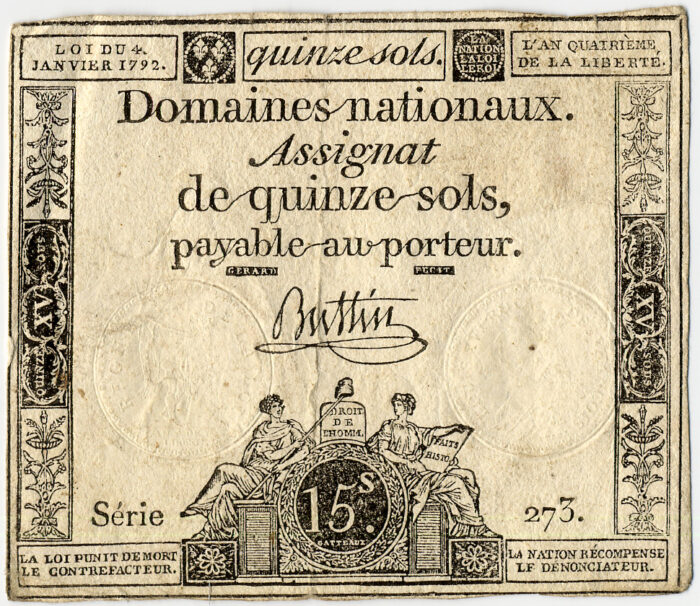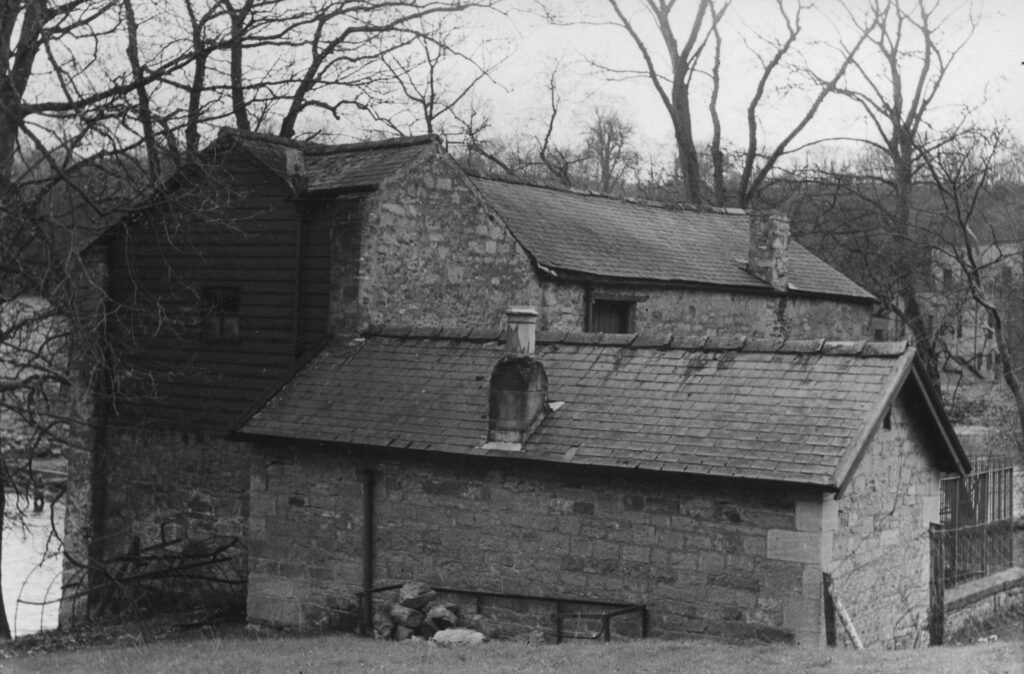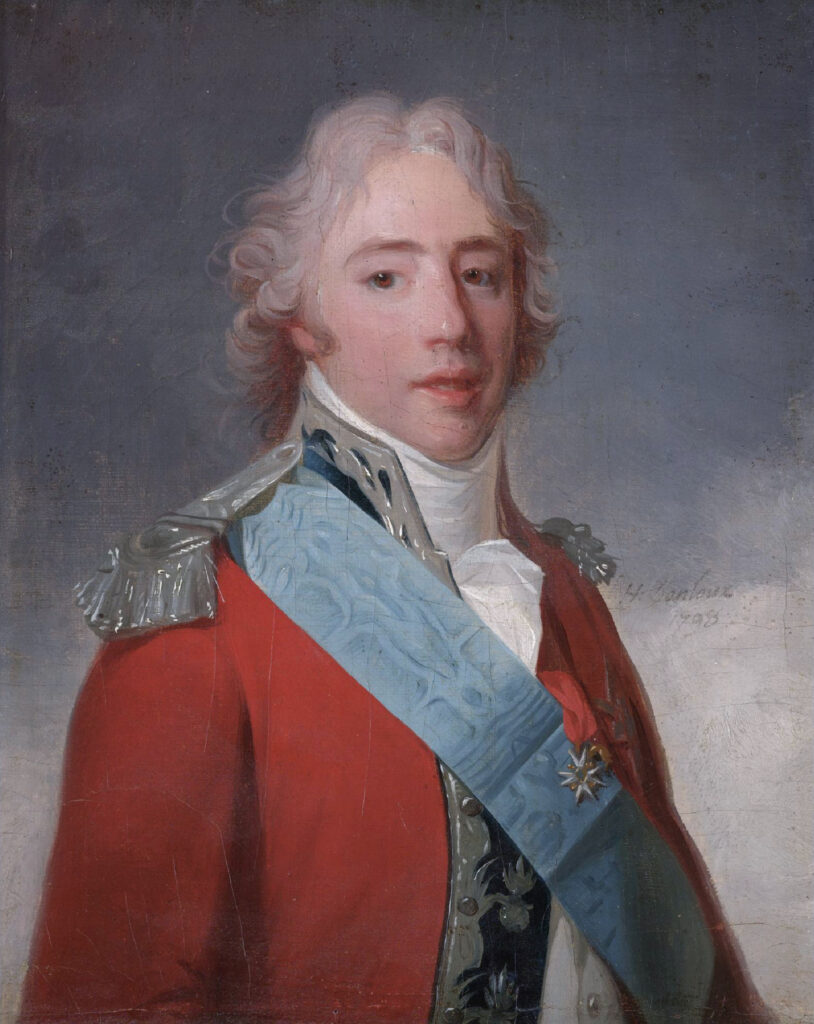
| A version of this article originally appeared as two posts on the Mills Archive blog in 2019. Mills have often played surprising and unexpected roles in world history. One example is the story of the part several English paper mills played in forging currency with the intent of undermining the French revolution. |
Assignats
| Assignats were a form of paper currency issued by the French Republic from 1789-1797. In November 1789, in order to raise finances and as part of its renunciation of the old feudal order, the National Assembly, the new government of France at the time, nationalised all church lands; a total of some 20,000 square miles, approx. 10% of the country. The idea was originally proposed by the then-Bishop of Autun, better known as Talleyrand, on 10th Oct 1789, the day Louis XVI became King of the French rather than the King of France (this meant he was still on the throne, but only precariously; the French people were becoming more powerful). The sale of these properties, the Domaines Nationaux, was to provide the financial base of the new regime, via the issue of interest-bearing bonds, or notes, called Assignats. Despite warnings from some members of the National Assembly that the release of so much land on to the market would devalue all property prices and thus the assignats, men like Thomas Lidet, part of the regicide, considered it patriotic to use them. He wrote that: ‘Assignats will soon be dispersed all over the country and, in spite of himself, every man who holds them will become a defender of the Revolution.’ |

| John Gamble, an Englishman working in Paris throughout this period, who had many connections with paper making in France and Britain, wrote in his journal about the paper from the mill owned by his brother in law, Leger Didot, at Essonnes near Paris. This was one of the paper-mills which supplied the government printing houses responsible for issuing assignats. He said: “The paper was frequently sent in a damp state in covered carts drawn by post horses to the printing office in Paris, was immediately printed and signed by the proper authorities during the night and as soon as the paper was sufficiently dry it was issued in the morning to the public. I remember the numerous laughs and jokes that took place when Didot returned from Paris with a small bundle of assignats under his arm which was all that he had received in payment for all the cartloads of paper. This was paper with which he had supplied the government; the only difference was that when they came back with Didot they had been printed and signed by some of the revolutionary demagogues then at the head of government.” Printing the paper before the sheets were properly dry gives an idea of the urgency of the French authorities’ need for currency. Paper would normally have been dried and cured before leaving the mill. |
Forgery
| Deliberate forgery of assignats was a perilous enterprise. Many attempts were made by private individuals, who in many cases met the worst punishment: the guillotine. The assignats had ‘La Loi Punit de Mort le Contrefacteur,’ (The Law Punishes the Counterfeiter with Death) printed on them as an attempt to dissuade people from attempting to produce forgeries. However, in Britain, forging assignats where French law had no means of tracing, catching or punishing the counterfeiters, was very effective. Sir John Swinburne, who was an investigator of the forgery at this time, wrote in his journal: “In the years 1793 and 1794, the government, Mr Pitt being [Prime] Minister, caused an immense number of assignats of various values to be fabricated in England and a prodigious quantity was poured into France…from Flanders and from the coast of Brittany for the rebels in La Vendée.” The intention was to destroy France’s economy or at the very least put it under considerable pressure. Paper for these assignats was produced for the British government by William Smith at Haughton Castle Mill, Northumberland and by John Finch in Dartford, Kent. |

| One of the best sources of information for the British role in the forgery is a memorandum written in 1773 by Sir John Swinburne, particularly his notes from a meeting with the foreman at Haughton Mill. This account also gives information on the role of Brook Watson, the then Director of the Bank of England, in the forgery. He also questions whether the government approached the Bank of England directly in order to put this plan together. It seems very likely that this was the case. |
Albury Park Mill
| In 1790, Charles Ball, a papermaker from Guildford took out a lease on a former corn mill in Albury Park and built a bank note paper mill. Mysteriously, he received many orders from an unknown client, who requested the watermarks to be modified on several occasions. Eventually Charles Ball discovered that his mysterious patron was in fact the Count of Artois, then in exile in England and later to became Charles X, the King of France and Navarre in 1824. Frequent changes to the watermarks were necessary because when officers of the Republic discovered the forgeries, they altered the form of the assignats to continue circulation and production. |

Painting by Henri-Pierre Danloux (1753–1809). Public domain, via Wikimedia Commons https://commons.wikimedia.org/wiki/File:Comte_d%27Artois,_later_Charles_X_of_France,_by_Henri_Pierre_Danloux.jpg
| On several occasions the Count visited the paper mill to order new paper, supervise the manufacture of new assignats and watermarks, and to take delivery of completed paper. An account written at the time shows he may have become more involved than he might have wished: “On one occasion he (Artois/ Charles X) required various changes to be made in the watermarks. The form-maker [maker of paper moulds and watermarks] of the mill was sent for. He was a young man named Longhelt, a native of Germany…[it] was explained to him, the alteration he wanted to be made and (Artois/ Charles X) sat down by his side for the purpose of seeing him begin his labour. Longhelt, who had been drinking, resented the intrusion and getting impatient at this stranger’s interventions, he waxed furious and threw the mould at the visitor’s head.” Charles Ball and his sons, Charles and Edmund Richard continued to work at Albury Park Mill until 1809, when a lease of 61 years was taken out on two newly-built paper mills at Postford (2.5km from Albury Park mill.) By 1810 Albury Park Mill was closed. |
The fate of the assignats
| Whilst it may have been the patriotic thing to do, those who used assignats incurred heavy losses. By May 1791 assignats had stopped bearing interest and by the time they were finally withdrawn in 1795 an assignat with a face value of 100 livre was worth a maximum of 15 sous. John Gamble recalled “The fate of the assignats is well known, I recollect being in Paris at the time they were ordered to be burnt and I saw their fragments flying over the heads of thousands of persons who had been utterly ruined by their introduction.” You can find out more about the forging of assignats in The Quarterly, the Journal of British paper historians, 106, April 2018: https://baph.org.uk/product/no-106-april-2018/?v=79cba1185463 |